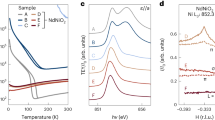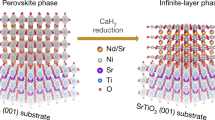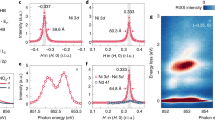Abstract
The search continues for nickel oxide-based materials with electronic properties similar to cuprate high-temperature superconductors1,2,3,4,5,6,7,8,9,10. The recent discovery of superconductivity in the doped infinite-layer nickelate NdNiO2 (refs. 11,12) has strengthened these efforts. Here, we use X-ray spectroscopy and density functional theory to show that the electronic structure of LaNiO2 and NdNiO2, while similar to the cuprates, includes significant distinctions. Unlike cuprates, the rare-earth spacer layer in the infinite-layer nickelate supports a weakly interacting three-dimensional 5d metallic state, which hybridizes with a quasi-two-dimensional, strongly correlated state with \(3d_{x^2-y^2}\) symmetry in the NiO2 layers. Thus, the infinite-layer nickelate can be regarded as a sibling of the rare-earth intermetallics13,14,15, which are well known for heavy fermion behaviour, where the NiO2 correlated layers play an analogous role to the 4f states in rare-earth heavy fermion compounds. This Kondo- or Anderson-lattice-like ‘oxide-intermetallic’ replaces the Mott insulator as the reference state from which superconductivity emerges upon doping.
This is a preview of subscription content, access via your institution
Access options
Access Nature and 54 other Nature Portfolio journals
Get Nature+, our best-value online-access subscription
$29.99 / 30 days
cancel any time
Subscribe to this journal
Receive 12 print issues and online access
$259.00 per year
only $21.58 per issue
Buy this article
- Purchase on Springer Link
- Instant access to full article PDF
Prices may be subject to local taxes which are calculated during checkout




Similar content being viewed by others
Code availability
QUANTUM ESPRESSO and Wannier90 are freely available at https://www.quantum-espresso.org and http://www.wannier.org, respectively. Access to RIXS exact diagonalization and Python analysis codes will be accommodated upon reasonable request to the corresponding authors.
Change history
13 July 2020
A Correction to this paper has been published: https://doi.org/10.1038/s41563-020-0761-1
References
Anisimov, V. I., Bukhvalov, D. & Rice, T. M. Electronic structure of possible nickelate analogs to the cuprates. Phys. Rev. B 59, 7901–7906 (1999).
Lee, K.-W. & Pickett, W. E. Infinite-layer LaNiO2: Ni1+ is not Cu2+. Phys. Rev. B 70, 165109 (2004).
Botana, A. S., Pardo, V. & Norman, M. R. Electron doped layered nickelates: spanning the phase diagram of the cuprates. Phys. Rev. Mater. 1, 021801(R) (2017).
Chaloupka, J. & Khaliullin, G. Orbital order and possible superconductivity in LaNiO3/LaMO3 superlattices. Phys. Rev. Lett. 100, 016404 (2008).
Hansmann, P. et al. Turning a nickelate Fermi surface into a cuprate-like one through heterostructuring. Phys. Rev. Lett. 103, 016401 (2009).
Middey, S. et al. Physics of ultrathin films and heterostructures of rare-earth nickelates. Annu. Rev. Mater. Res. 46, 305–334 (2016).
Boris, A. V. et al. Dimensionality control of electronic phase transitions in nickel-oxide superlattices. Science 332, 937–940 (2011).
Benckiser, E. et al. Orbital reflectometry of oxide heterostructures. Nat. Mater. 10, 189–193 (2011).
Disa, A. S. et al. Orbital engineering in symmetry-breaking polar heterostructures. Phys. Rev. Lett. 114, 026801 (2015).
Zhang, J. et al. Large orbital polarization in a metallic square-planar nickelate. Nat. Phys. 13, 864–869 (2017).
Li, D. et al. Superconductivity in an infinite-layer nickelate. Nature 572, 624–627 (2019).
Sawatzky, G. A. Superconductivity seen in a nickel oxide. Nature 572, 592–593 (2019).
Fisk, Z., Ott, H. R., Rice, T. M. & Smith, J. L. Heavy-electron metals. Nature 320, 124–129 (1986).
Coles, B. R. Heavy-fermion intermetallic compounds. Contemp. Phys. 28, 143–157 (1987).
Stewart, G. R. Non-Fermi-liquid behavior in d- and f-electron metals. Rev. Mod. Phys. 73, 797–855 (2001).
Mott, N. F. & Peierls, R. Discussion of the paper by de Boerand Verwey. Proc. Phys. Soc. 49, 72–73 (1937).
Lee, P. A., Nagaosa, N. & Wen, X.-G. Doping a Mott insulator: physics of high-temperature superconductivity. Rev. Mod. Phys. 78, 17–85 (2006).
Crespin, M. O., Isnard, O., F. Dubois, F., Choisnet, J. & Odier, P. LaNiO2: synthesis and structural characterization. J. Solid State Chem. 178, 1326–1334 (2005).
Hayward, M. A., Green, M. A., Rosseinsky, M. J. & Sloan, J. Sodium hydride as a powerful reducing agent for topotactic oxide deintercalation: synthesis and characterization of the nickel(i) oxide LaNiO2. J. Am. Chem. Soc. 121, 8843–8854 (1999).
Ikeda, A., Krockenberger, Y., Irie, H., Naito, M. & Yamamoto, H. Direct observation of infinite NiO2 planes in LaNiO2 films. Appl. Phys. Express 9, 061101 (2016).
Zaanen, J., Sawatzky, G. A. & Allen, J. W. Band gaps and electronic structure of transition-metal compounds. Phys. Rev. Lett. 55, 418 (1985).
Kuiper, P., Kruizinga, G., Ghijsen, J. & Sawatzky, G. A. Character of holes in LixNi1 − xO and their magnetic behavior. Phys. Rev. Lett. 62, 221 (1989).
Kurmaev, E. Z. et al. Oxygen X-ray emission and absorption spectra as a probe of the electronic structure of strongly correlated oxides. Phys. Rev. B 77, 165127 (2008).
Bisogni, V. et al. Ground-state oxygen holes and the metal–insulator transition in the negative charge-transfer rare-earth nickelates. Nat. Commun. 7, 13017 (2016).
Zaanen, J. & Sawatzky, G. A. Systematics in band gaps and optical spectra of 3D transition metal compounds. J. Solid State Chem. 88, 8–27 (1990).
Chen, C. T. et al. Electronic states in La2 − xSrxCuO4 + δ probed by soft-X-ray absorption. Phys. Rev. Lett. 66, 104 (1991).
Grioni, M. et al. Studies of copper valence states with Cu L3 X-ray-absorption spectroscopy. Phys. Rev. B 39, 1541 (1989).
Anisimov, V. I., Zaanen, J. & Anderson, O. K. Band theory and Mott insulators: Hubbard U instead of Stoner I. Phys. Rev. B 44, 943 (1991).
Haverkort, M. W., Zwierzycki, M. & Andersen, O. K. Multiplet ligand-field theory using Wannier orbitals. Phys. Rev. B 85, 165113 (2012).
Kawai, M. et al. Reversible changes of epitaxial thin films from perovskite LaNiO3 to infinite-layer structure LaNiO2. Appl. Phys. Lett. 94, 082102 (2009).
Ikeda, A., Manabe, T. & Naito, M. Improved conductivity of infinite-layer LaNiO2 thin films by metal organic decomposition. Phys. C 495, 134–140 (2013).
Strocov, V. N. et al. High-resolution soft X-ray beamline ADRESS at the Swiss Light Source for resonant inelastic X-ray scattering and angle-resolved photoelectron spectroscopies. J. Synchrotron Radiat. 17, 631–643 (2010).
Cococcioni, M. & de Gironcoli, S. Linear response approach to the calculation of the effective interaction parameters in the LDA + U method. Phys. Rev. B 71, 035105 (2005).
Giannozzi, P. et al. QUANTUM ESPRESSO: a modular and open-source software project for quantum simulations of materials. J. Phys. Condens. Matter 21, 395502 (2009).
Jia, C. J. et al. Persistent spin excitations in doped antiferromagnets revealed by resonant inelastic light scattering. Nat. Commun. 5, 3314 (2014).
Jia, C., Wohlfeld, K., Wang, Y., Moritz, B. & Devereaux, T. P. Using RIXS to uncover elementary charge and spin excitations. Phys. Rev. X 6, 021020 (2016).
Mostofi, A. A. et al. An updated version of Wannier90: a tool for obtaining maximally-localised Wannier functions. Comput. Phys. Commun. 185, 2309–2310 (2014).
Acknowledgements
We thank G.A. Sawatzky and E. Benckiser for discussions. This work is supported by the US Department of Energy (DOE), Office of Science, Basic Energy Sciences, Materials Sciences and Engineering Division, under contract no. DE-AC02-76SF00515. X.F. and D.L. acknowledge partial support from the Gordon and Betty Moore Foundation’s EPiQS Initiative through grant no. GBMF4415. Part of the synchrotron experiments were performed at the ADRESS beamline of the Swiss Light Source (SLS) at the Paul Scherrer Institut (PSI). The work at PSI is supported by the Swiss National Science Foundation through the NCCR MARVEL (research grant no. 51NF40_141828) and the Sinergia network Mott Physics Beyond the Heisenberg Model—MPBH (research grant no. CRSII2_160765/1). Part of the research was conducted at the Advanced Light Source (ALS), which is a DOE Office of Science User Facility, under contract no. DE-AC02-05CH11231. We acknowledge preliminary XAS characterization at BL13-3, SSRL by J.S. Lee in the early stage of the project.
Author information
Authors and Affiliations
Contributions
W.S.L., M.H. and H.Y. Hwang conceived the experiment. M.H., H.L., E.P., Y.T., T.S. and W.S.L. conducted the experiment at SLS. H.L., W.S.L., Z.H. and Y.-D.C. conducted the experiment at ALS. H.L., W.S.L., A.N. and K.J.Z. conducted XAS measurement at Diamond Light Source. M.R., W.S.L., H.Y. Huang and D.J.H. conducted XAS measurements at NSRRC. J.S.L. contributed to XAS characterization of samples at an early stage of the work. M.H., H.L. and W.S.L. analysed the data. C.J.J., B.M., J.Z. and T.P.D. performed the theoretical calculations. D.L., X.F., Y.H., M.O. and H.Y. Hwang synthesized and characterized the nickelate samples using transport and XRD. M.H., Z.X.S. and W.S.L. prepared and aligned samples for X-ray spectroscopy measurements. M.H., B.M., J.Z. and W.S.L. wrote the manuscript with input from all authors.
Corresponding authors
Ethics declarations
Competing interests
The authors declare no competing interests.
Additional information
Publisher’s note Springer Nature remains neutral with regard to jurisdictional claims in published maps and institutional affiliations.
Extended data
Extended Data Fig. 1 XRD characterization and electrical transport measurements.
a, XRD pattern of the LaNiO3, LaNiO2.5, and LaNiO2 films grown on SrTiO3 (001) substrates, measured with Cu Kα radiation. The red arrows indicate the nickelate film peaks and the black arrow the (002) SrTiO3 substrate peak. The film peak shifts to higher 2θ values as a function of apical oxygen reduction. The curves are offset in vertical direction for clarity. b, Resistivity vs. temperature of the LaNiO3 and LaNiO2 film.
Extended Data Fig. 2 Ni L-edge, La M4-edge and Nd M5-edge x-ray absorption spectra (XAS).
a, XAS of LaNiO3 and LaNiO2 across the Ni L3,2-edge before subtraction of the La M4 absorption peak. The XAS of NiO powder is also shown. Spectra are offset in vertical direction for clarity. b, XAS of NdNiO3 and NdNiO2 across the Nd M5-edge. The XAS were taken using total fluorescence yield. The XAS spectra across the rare-earth M-edges of the La- and Nd-based infinite-layer nickelates are essentially identical to those of their perovskite counterparts (LaNiO3 and NdNiO3). This implies a similar configuration of 4f states for both types of nickelates and that the 4f states of La3+ and Nd3+ do not hybridize in any significant way with the Ni 3d states.
Extended Data Fig. 3 RIXS maps across the La M4-edge.
RIXS maps for (left) LaNiO2 and (right) LaNiO3 with incident photon energies including the La M4 edge. No orbital excitations exist in the inelastic channel of the RIXS spectra. This is consistent with a nominally empty 4f shell of the La3+ ion, implying that the 4f states are far from near-EF states and not hybridized with the Ni 3d states.
Supplementary information
Supplementary Information
Supplementary Tables 1–3.
Rights and permissions
About this article
Cite this article
Hepting, M., Li, D., Jia, C.J. et al. Electronic structure of the parent compound of superconducting infinite-layer nickelates. Nat. Mater. 19, 381–385 (2020). https://doi.org/10.1038/s41563-019-0585-z
Received:
Accepted:
Published:
Issue Date:
DOI: https://doi.org/10.1038/s41563-019-0585-z
This article is cited by
-
Strain-mediated phase crossover in Ruddlesden–Popper nickelates
Communications Materials (2024)
-
Direct observation of strong surface reconstruction in partially reduced nickelate films
Nature Communications (2024)
-
Absence of 3a0 charge density wave order in the infinite-layer nickelate NdNiO2
Nature Materials (2024)
-
Evidence for d-wave superconductivity of infinite-layer nickelates from low-energy electrodynamics
Nature Materials (2024)
-
Structural transition, electric transport, and electronic structures in the compressed trilayer nickelate La4Ni3O10
Science China Physics, Mechanics & Astronomy (2024)



